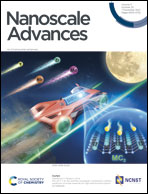Covalent and non-covalent coupling of a Au102 nanocluster with a fluorophore: energy transfer, quenching and intracellular pH sensing†
Abstract
Interactions between an atomically precise gold nanocluster Au102(p-MBA)44 (p-MBA = para mercaptobenzoic acid) and a fluorescent organic dye molecule (KU, azadioxatriangulenium) are studied. In solution, the constituents form spontaneously a weakly bound complex leading to quenching of fluorescence of the KU dye via energy transfer. The KU can be separated from the complex by lowering pH, leading to recovery of fluorescence, which forms a basis for an optical reversible pH sensor. However, the sensor is not a stable entity, which could be delivered inside cells. For this purpose, a covalently bound hybrid is synthesized by linking the KU dye to the ligand layer of the cluster via an ester bond. Covalent linking facilitates entry of the cluster–dye hybrids into cells via endocytosis. Inside cells, the hybrids accumulate in endosomes where Au102 releases its cargo via hydrolysis of the ester bond. Changes of the local pH inside endosomes regulate reversible fluorescence due to variations in the interactions between the Au102 cluster and the dye. This work presents a concept for delivering reporter molecules into cells by using atomically precise gold nanoclusters as carriers and paves the way for future developments of cluster-reporter sensors for in vivo measurements of e.g. absolute pH values or ion concentrations.



 Please wait while we load your content...
Please wait while we load your content...